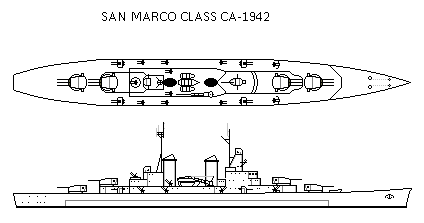
San Marco, Italy Cruiser laid down 1943
Displacement:
11,538 t light; 12,099 t standard; 13,498 t normal; 14,618 t full load
Dimensions: Length (overall / waterline) x beam x draught (normal/deep)
(580.92 ft / 570.00 ft) x 69.00 ft x (21.00 / 22.40 ft)
(177.06 m / 173.74 m) x 21.03 m x (6.40 / 6.83 m)
Armament:
12 - 8.00" / 203 mm 45.0 cal guns - 258.18lbs / 117.11kg shells, 150 per gun
Breech loading guns in turret on barbette mounts, 1943 Model
4 x Twin mounts on centreline ends, evenly spread
2 raised mounts - superfiring
2 x Twin mounts on centreline ends, evenly spread
2 double raised mounts
6 - 4.00" / 102 mm 45.0 cal guns - 32.27lbs / 14.64kg shells, 250 per gun
Breech loading guns in deck mounts, 1943 Model
6 x Single mounts on sides, evenly spread
2 raised mounts
36 - 1.00" / 25.4 mm 45.0 cal guns - 0.50lbs / 0.23kg shells, 500 per gun
Breech loading guns in deck mounts, 1943 Model
8 x Quad mounts on sides, evenly spread
2 raised mounts
1 x Quad mount layout not set
1 raised mount
Weight of broadside 3,310 lbs / 1,501 kg
Main Torpedoes
4 - 21.0" / 533 mm, 26.00 ft / 7.92 m torpedoes - 1.746 t each, 6.983 t total
In 2 sets of deck mounted carriage/fixed tubes
Armour:
- Belts: Width (max) Length (avg) Height (avg)
Main: 4.00" / 102 mm 390.00 ft / 118.87 m 18.00 ft / 5.49 m
Ends: Unarmoured
Main Belt covers 105 % of normal length
- Torpedo Bulkhead - Strengthened structural bulkheads:
2.00" / 51 mm 400.00 ft / 121.92 m 40.00 ft / 12.19 m
Beam between torpedo bulkheads 60.00 ft / 18.29 m
- Gun armour: Face (max) Other gunhouse (avg) Barbette/hoist (max)
Main: 8.00" / 203 mm 4.00" / 102 mm 4.00" / 102 mm
2nd: 2.00" / 51 mm 1.00" / 25 mm -
3rd: 1.00" / 25 mm - -
- Protected deck - single deck:
For and Aft decks: 1.00" / 25 mm
Forecastle: 0.50" / 13 mm Quarter deck: 0.50" / 13 mm
Machinery:
Oil fired boilers, steam turbines,
Hydraulic drive, 2 shafts, 110,628 shp / 82,529 Kw = 32.00 kts
Range 5,000nm at 20.00 kts
Bunker at max displacement = 2,519 tons
Complement:
625 - 813
Cost:
£7.236 million / $28.944 million
Distribution of weights at normal displacement:
Armament: 737 tons, 5.5 %
- Guns: 729 tons, 5.4 %
- Weapons: 9 tons, 0.1 %
Armour: 3,743 tons, 27.7 %
- Belts: 1,171 tons, 8.7 %
- Torpedo bulkhead: 1,184 tons, 8.8 %
- Armament: 914 tons, 6.8 %
- Armour Deck: 474 tons, 3.5 %
Machinery: 2,857 tons, 21.2 %
Hull, fittings & equipment: 4,176 tons, 30.9 %
Fuel, ammunition & stores: 1,960 tons, 14.5 %
Miscellaneous weights: 25 tons, 0.2 %
- Above deck: 25 tons
Overall survivability and seakeeping ability:
Survivability (Non-critical penetrating hits needed to sink ship):
19,239 lbs / 8,727 Kg = 75.2 x 8.0 " / 203 mm shells or 2.3 torpedoes
Stability (Unstable if below 1.00): 1.12
Metacentric height 3.6 ft / 1.1 m
Roll period: 15.3 seconds
Steadiness - As gun platform (Average = 50 %): 52 %
- Recoil effect (Restricted arc if above 1.00): 0.73
Seaboat quality (Average = 1.00): 1.04
Hull form characteristics:
Hull has a flush deck,
a normal bow and a cruiser stern
Block coefficient (normal/deep): 0.572 / 0.581
Length to Beam Ratio: 8.26 : 1
'Natural speed' for length: 23.87 kts
Power going to wave formation at top speed: 62 %
Trim (Max stability = 0, Max steadiness = 100): 50
Bow angle (Positive = bow angles forward): 20.00 degrees
Stern overhang: -5.00 ft / -1.52 m
Freeboard (% = length of deck as a percentage of waterline length):
Fore end, Aft end
- Forecastle: 20.00 %, 30.00 ft / 9.14 m, 24.00 ft / 7.32 m
- Forward deck: 30.00 %, 24.00 ft / 7.32 m, 24.00 ft / 7.32 m
- Aft deck: 35.00 %, 24.00 ft / 7.32 m, 24.00 ft / 7.32 m
- Quarter deck: 15.00 %, 24.00 ft / 7.32 m, 24.00 ft / 7.32 m
- Average freeboard: 24.48 ft / 7.46 m
Ship space, strength and comments:
Space - Hull below water (magazines/engines, low = better): 103.6 %
- Above water (accommodation/working, high = better): 203.6 %
Waterplane Area: 28,021 Square feet or 2,603 Square metres
Displacement factor (Displacement / loading): 109 %
Structure weight / hull surface area: 128 lbs/sq ft or 623 Kg/sq metre
Hull strength (Relative):
- Cross-sectional: 0.93
- Longitudinal: 1.89
- Overall: 1.00
Adequate machinery, storage, compartmentation space
Excellent accommodation and workspace room
Ships in class expected: 2-3?

Quoted
Originally posted by Rodondo

Quoted
Originally posted by RodondoQuoted
Originally posted by Rodondo